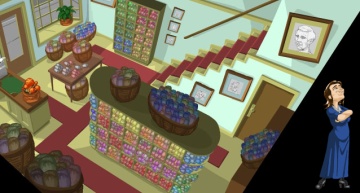I have been thinking about Bernstein's Challenge for quite a while now. See, Interactive Fiction was what initially interested me in hypertext. In my mind, they are very much related.
So when I saw The Witch's Yarn listed as an innovative interactive fiction on a game site, I was immediately interested. I downloaded a copy.

I won't go into a detailed description of the story. There's a thorough description and review of The Witch's Yarn at Adventure Gamers.
But here's the basic story. The protagonist is a witch (described in an innocuous, Harry Potter-ish sort of way -- not a dark/evil sort of way) who has decided to abandon the ways of magic and start a home business -- selling yarn.
Now, your traditional IF would have made the user the protagonist. But Keith Nemitz has learned the lesson of Galatea. Instead of choosing what the protagonist should do, the user chooses which character should enter the scene next. I think this is a really smart way to do interactive fiction. It's actually more like hypertext in that regard, since you don't actually type anything. You just click the icon for a character.
The story is like IF in that there are puzzles to solve. But the puzzles are not your ordinary type of IF puzzle. In the first chapter, you have to help the character progress to make some yarn while at the same time come unscathed from an argument with her mother. If she gets too discouraged or frustrated, she will give up.
In the second chapter, you have to help her keep her calm while she opens for business. She deals with memories of her family, of her dead husband at the same time she has to handle the community opposition to her business.
This section would be brilliant if not for the annoying mushroom familiar who's always saying things like, "Oh no! I'm afraid that if she gets any angrier, she might quit! Try to cheer her up." There are also too many dead ends. This story and software concepts work well enough that there shouldn't have to be any dead ends.
The amusing part is that you never know what will happen when you introduce a new character, at least not until you see them interact with the protagonist and get to know them better. And of course, their attitude may change along the way. This gets around the difficulties recently outlined by Mark Bernstein. Mark says:
The Witch's Yarn is all about the characters. Unlike traditional IF, the user is *not* a character. This allows the story's creator to fully define the personalities and actions of characters while allowing wide-ranging user interaction.
The actual writing is so-so, imho. I think the puzzles tend to get in the way of what otherwise is a great story. The graphics are pretty good. My only graphics peeve is that character images are not antialiased, which makes some scenes look pretty bad.
I think the concept of the puzzle is unfortunate tendency of too much IF. Puzzles are fun. They are also helpful to the author. They narrow the a branching story down to a specific point at their solution. The story can then start branching again. But must every IF be puzzle-based? (this is changing due to the increased discussion about IF as a literary form
The Witch's Yarn uses puzzles, but also introduces another concept: chapters.
The game is structured in chapters, which I like. Readers can undo back to the beginning of a chapter. But more importantly, it the story within a chapter can range widely without requiring the whole story to be a set of branches that get too far out of control or too bulky for the writer. Although the chapters proceed linearly, I imagine that one could potentially write multiple chapters 2, 3, etc. for a similar work.
I think that this type of game has a great potential for demonstrating what can be done when the player is a third party without direct control over the plot. This, imho, is the easiest way to guarantee large amounts of reader freedom. It makes me think of a lot of late 19th century, early 20th century novels where the entire novel was from the perspective of a constructed narrator.
By further restricting the user from actually deciding actions, The Witch's Yarn is more like a hypertext than a traditional IF. Indeed, it would be very easy to design this sort of hypertext in StorySpace.(Sorry Tinderboxers, I think you need guard fields on this one, though I think it's possible to hack-implement guard fields on export) I think this character/theatre concept should be further explored.
CineProse
The Witch's Yarn is built using an adventure engine designed by its publisher. This Python-based engine (I peeked in the executable -- the actual text is bzipped) presumably allows writers to piece together graphics and sound to make similar works. According to this blog post by peterb, the CineProse engine will be made available for other developers.
While I would probably feel more at home designing something like this in StorySpace, I certainly look forward to seeing the tools, and more importantly, seeing the stories inspired by this interesting adventure game.

